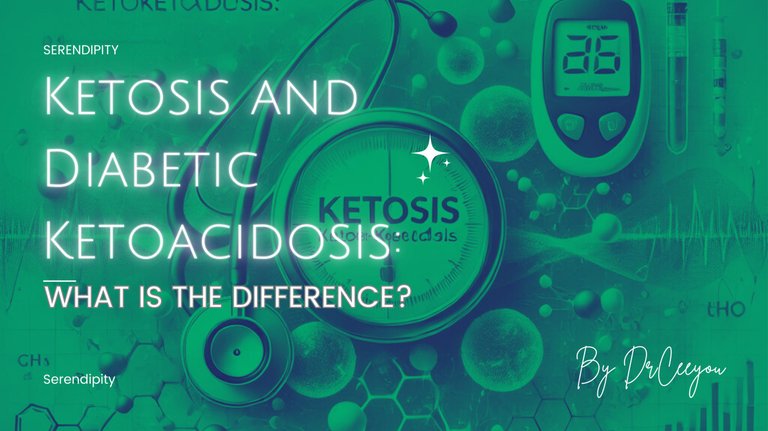Ketosis vs. Diabetic Ketoacidosis (DKA): What’s the Difference?

You are probably familiar with diabetes, a condition where the body is unable to use glucose effectively to produce energy. This typically occurs because the body cannot produce enough insulin, the hormone necessary for glucose utilization.
Now, imagine the body becomes so deficient in insulin that it cannot use the glucose in the blood. In this scenario, the body must find an alternative energy source to function.
This is what happens when a person with diabetes develops diabetic ketoacidosis (DKA). The body shifts to producing ketones as its primary energy source because it cannot use glucose due to the lack of insulin. When this occurs, the body produces excessive ketones, insulin levels are critically low, and the individual becomes seriously ill.
On the other hand, with the rise of the keto diet, there has been a significant shift toward achieving ketosis. The keto diet, initially introduced to help manage epilepsy, has gained popularity for its reported benefits in controlling blood sugar and blood pressure.
While both ketosis and DKA involve elevated ketone levels, they are fundamentally different. Ketosis is a controlled, natural metabolic state, whereas DKA is a life-threatening medical emergency. Let’s explore these two conditions in detail.
What Is Ketosis?
Ketosis is a metabolic state in which your body burns fat (in the form of ketones) for fuel instead of glucose. This occurs under the following circumstances:
- You’re following a ketogenic diet (low-carb, high-fat).
- You’re fasting or starving.
- You’ve engaged in intense exercise without sufficient carbohydrate intake.
How It Works:
- When carbohydrates are scarce, your body depletes its glucose stores for energy. Once glucose is exhausted,
- Your liver converts fat into ketones (acetoacetate, beta-hydroxybutyrate, and acetone), which your brain and muscles then use as fuel.
- Blood ketone levels rise, but blood pH (acidity) remains normal. Blood sugar levels also stay normal or may even become slightly low.
In this state, individuals often experience reduced hunger and increased energy, as ketones provide a longer-lasting fuel source compared to glucose. Some people may also notice a sweet-smelling breath, often referred to as "keto breath."
What Is Diabetic Ketoacidosis (DKA)?
DKA is a dangerous complication of diabetes, most commonly seen in Type 1 diabetes. It occurs when ketone production spirals out of control, leading to acidic blood and severe dehydration.
How It Works:
- Without sufficient insulin, your cells cannot use glucose for energy.
- Your body begins breaking down fat at an alarming rate, flooding the bloodstream with ketones.
- Excess ketones make the blood acidic, disrupting vital bodily functions.
Key Features of DKA:
- Ketone levels: Much higher than in ketosis.
- Blood sugar: Extremely high (>250 mg/dL).
- Symptoms: Severe, including nausea, vomiting, abdominal pain, confusion, fruity-smelling breath, and rapid breathing.
- Safety: Life-threatening; requires immediate medical attention.
Key Differences at a Glance
| Aspect | Ketosis | Diabetic Ketoacidosis (DKA) |
|---|---|---|
| Cause | Low-carb diet, fasting, exercise | Insulin deficiency (usually Type 1 diabetes) |
| Ketone Levels | 0.5–3.0 mmol/L | >3.0 mmol/L (often much higher) |
| Blood Sugar | Normal or slightly low | Very high (>250 mg/dL) |
| Blood pH | Normal | Acidic (dangerously low) |
| Symptoms | Mild (e.g., keto breath, energy) | Severe (e.g., vomiting, confusion) |
| Risk Level | Generally safe | Life-threatening |
Why the Confusion?
Both ketosis and DKA involve the production of ketones, but the context is crucial:
- Ketosis is a controlled, adaptive state—your body uses fat for fuel because you’ve limited carbohydrate intake.
- DKA is a pathological, out-of-control state—your body breaks down fat because it cannot use glucose due to insulin deficiency.
Who’s at Risk for DKA?
- Type 1 diabetics: Their bodies do not produce insulin, making DKA a constant risk if insulin is not properly managed.
- Type 2 diabetics (rarely): DKA can occur during severe illness or insulin deficiency.
- Non-diabetics (extremely rare): Prolonged starvation or alcoholism can trigger a DKA-like state.
Can a Keto Diet Cause DKA?
For most people, no. Ketosis from a keto diet is safe because:
- Insulin levels remain sufficient to regulate blood sugar and ketone production.
- Blood pH stays within a normal range.
However, diabetics on a keto diet should monitor closely, as insulin mismanagement could increase the risk of DKA.
When to Worry: Red Flags for DKA
If you’re on a keto diet and experience any of the following symptoms, seek medical help immediately:
- Persistent nausea or vomiting.
- Severe abdominal pain.
- Confusion or difficulty breathing.
- Fruity-smelling breath.
In Summary
Ketosis and DKA are metabolic cousins, not twins. Ketosis is a tool for weight loss or metabolic health, while DKA is a medical emergency. Understanding the difference could save a life—especially for diabetics or those considering a keto diet.
Thumbnail created with Canva
@drceeyou, one of your Hive friends wishes you a Happy Valentine's day and asked us to give you a new badge!
To find out who wanted you to receive this special gift, click here!
You can view your badges on your board and compare yourself to others in the Ranking
Check out our last posts: